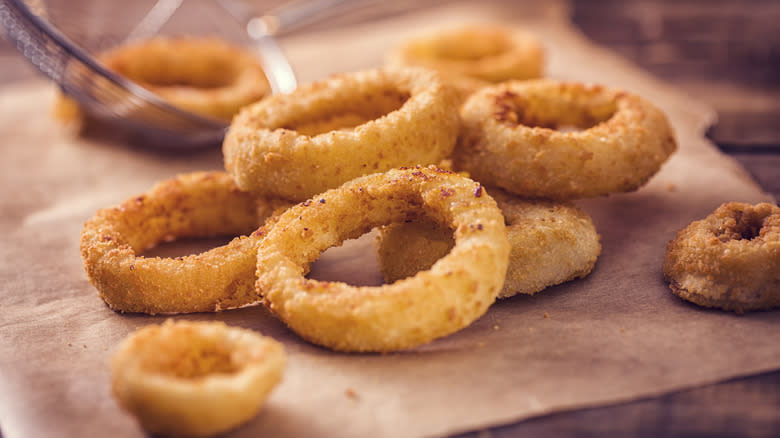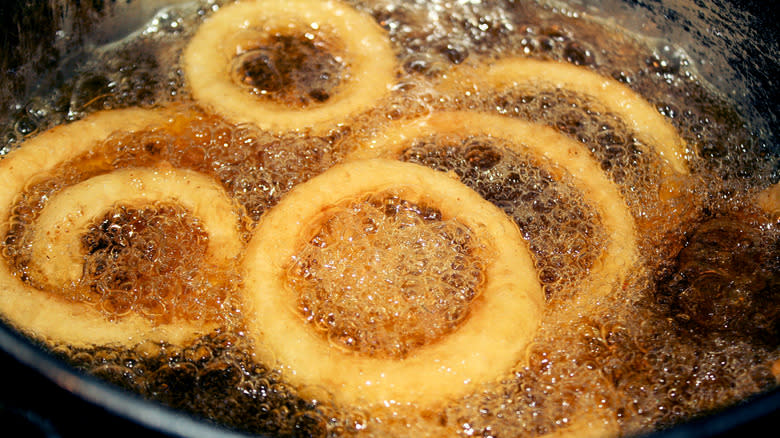Prevent Onion Ring Batter From Falling Off With One Crucial Step

Perfectly cooked onion rings offer a crunchy, savory, satisfying party for the palate that keeps you reaching for "just one more." In fact, we'd go so far as to say battered and fried onion rings are synonymous with indulgence. With a soft, silky onion on the inside counterbalanced by a satisfyingly crispy exterior, onion rings rank high on the cravings scale. You're thinking of them now, aren't you?
On the other hand, onion rings that fall apart while they cook or when you take a bite are less than impressive. There are myriad ways the preparation of onion rings can go wrong. They can lack adequate breading or leave you with a noodle of an onion hanging out of your mouth whilst the breading remains in your hand. Avoid these catastrophes by ensuring the batter adheres to the surface of the onion so each bite results in the perfect combination of flavors and textures. To achieve this goal, the key is to dust your onions with a common household pantry item -- cornstarch -- before plunging them into the batter.
Read more: 15 Tricks For Making The Most Crispy Chicken Thighs Ever
The Lowdown On The Cornstarch Dip

The reason a cornstarch dusting will help your batter adhere is because it provides a gritty texture for the batter to grab onto. Without it, the batter may not bind to the slick surface of the onion. Flour can also be used, but since cornstarch doesn't contain any gluten, it won't add to the weightiness of the breading. Flour, on the other hand, is often used in the batter, but too much of it will result in a dense, rather than light and airy, bite. This is why swapping in cornstarch for dusting is a move that improves adhesion without additional density.
Unlike flour, cornstarch does not contain protein and therefore doesn't brown. The amino acids in protein are a key component in a chemical reaction called the Maillard Reaction, which explains the reason proteins cause browning. Since you do want some browning to occur when frying your onion rings, flour in the batter serves this important job. However, extra flour can equate to extra browning, so use cornstarch for the dusting layer instead.
Other Reasons Your Onions And Batter Go Through A Separation

Preventing your batter from falling off your onions requires a delicate balance of ingredients and proper technique. If dusting your onions with cornstarch doesn't net the result you're looking for, evaluate some other steps in the onion ring-making process. For example, be sure to dry your onions if you choose to pre-soak them. Batter doesn't adhere well to a wet surface (but cornstarch does!). You may also want to remove the onion's protective membrane to expose the more textured layer below.
When it comes to batter, ensure it's not too thin or it will drip right off your onion ring. Also, make sure your batter is ice cold, as this makes for a lighter coating when it's fried. In contrast, ensure your oil is piping hot at around 360 to 375 degrees Fahrenheit before dropping in your battered rings. If the oil isn't hot enough, the dough will absorb the oil, creating soggy onion rings that may fall apart. Also, for the best onion rings ever, be sure not to overcrowd the frying vessel: Give your onion rings room to move around. Leaving space around them also results in better temperature moderation so your oil stays hot.
Read the original article on Daily Meal.

